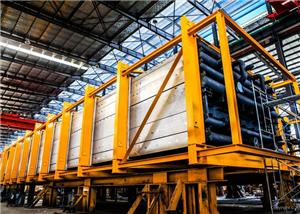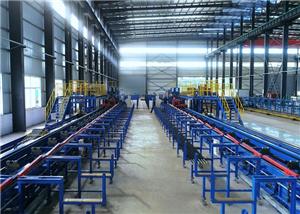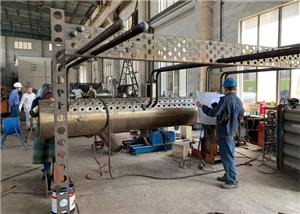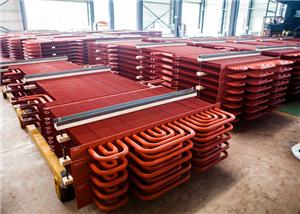-
1.Các loại nhiệt thải được thu hồi từ lò hơi nhiệt thải
The principle of waste heat boiler is that the fuel oil, gas and coal are burned to produce the heat emission of high-temperature flue gas. The high-temperature flue gas first enters the furnace chamber, then enters the waste heat recovery device of the front smoke box, then enters the pyrotechnics pipe, and finally enters the waste heat recovery device of the flue pipe of the back smoke box. The high-temperature flue gas turns into low-temperature flue gas and is discharged into the atmosphere through the stack. 1. High temperature flue gas waste heat: it is a common form, its characteristics are large output, concentrated production point, strong continuity, easy to recover and use, heat absorb accounted for 40~50% of the total heat, the waste heat boiler recovery heat, can be used in production or daily life heat and power generation. 2. Residual heat from high temperature furnace slag, 3. High temperature product waste heat: such as steel billet, high temperature forging part etc, 4. The residual heat of combustible waste gas and liquid waste, 5. Residual heat of chemical reaction, 6. Residual heat of cooling medium, 7. Waste heat from condensation water.
-
2.Tại sao HRSG sử dụng ống có vây
Lý do tại sao các ống vây được sử dụng trong HRSG: để cải thiện hiệu quả của lò hơi nhiệt thải, phải giảm chênh lệch nhiệt độ giữa nhiệt độ khói và nhiệt độ hơi của lò hơi. Có mâu thuẫn diện tích, điện trở và nhiệt độ. Khu vực sưởi ấm của lò hơi nhiệt thải sẽ được tăng lên. Để giảm tổn thất điện trở dòng, diện tích dòng chảy có thể được tăng lên và tốc độ dòng chảy có thể giảm. Tuy nhiên, lưu lượng tốc độ thấp bị ràng buộc để giảm hiệu quả truyền nhiệt; Vì vậy, để tăng diện tích truyền nhiệt; Đổi lại, diện tích của HRSG sẽ tăng lên vô cùng; Việc sử dụng ống vây xoắn ốc có thể đảm bảo đủ diện tích truyền nhiệt, tăng cường truyền nhiệt và có thể làm giảm sức cản của khí thải!
-
3.Mẹo nồi hơi
1. The drum is connected by a riser and a downcomer to form a natural circulation loop.Upper drum is filled with water and steam mixture from circulation loop,normally there will be water steam seperating device and feeding water distribution pipe.In order to improve the quality of boiler water some boilers are also equipped with continuous sewage pipe and dosing pipe. There is a regular sewage discharge device in the lower drum. On the outer wall of the upper boiler drum of steam boiler, there are also flanged short pipes connecting the main steam pipe and the secondary steam pipe and flanges and short pipes connecting the continuous water level gauge, pressure gauge, safety valve and other accessories. There is a regular blowdown device for discharging sediment in the lower boiler drum. 2. For larger capacity boilers, simply using natural separation of steam and water can no longer meet the requirements, need to install a seperating device inside upper drum. 3. The water-cooled wall tube is usually a no.10 or no.20 seamless steel tube with an outer diameter of 51~76mm and a wall thickness of 3.5~6.0mm. The distance between the center of the tube is generally 1.25~2 times of the outer diameter of the tube.Both finned tubes and bare tubes. 4. Water - cooled walls are generally fixed on the upper, the lower can be free expansion. 5. The function of steam superheater is to heat the saturated steam drawn out of the upper drum to a certain temperature of the superheated steam. Industrial steam is mostly saturated steam, so normally general boiler are not equipped with steam superheater. A steam superheater is installed in the boiler only if the production steam requires a higher temperature and does not require an increase in steam pressure, or if superheated steam is required in order to reduce condensation losses during steam transmission. In industrial boilers, the temperature of superheated steam is 250℃ and 350℃ for the boilers with working pressure of 1.25MPa, and 350℃ for the boilers with working pressure of 1.6MPa.
-
4.Kiến thức cơ bản về nồi hơi
Lò hơi dùng để chỉ các thiết bị sử dụng năng lượng nhiệt được giải phóng khi đốt nhiên liệu hoặc năng lượng nhiệt khác để đun nóng nước hoặc môi trường làm việc khác để tạo ra hơi nước hoặc nước nóng với các thông số cụ thể (nhiệt độ, áp suất) và chất lượng. Phân loại nồi hơi: Ứng dụng: Nồi hơi nhà máy điện, nồi hơi công nghiệp Hơi nước: nồi hơi áp suất siêu tới hạn, nồi hơi áp suất hạ áp, nồi hơi áp suất cao, nồi hơi áp suất cao, nồi hơi áp suất trung bình, nồi hơi áp suất thấp. Khả năng bay hơi: Quy mô lớn, kích thước trung bình, kích thước nhỏ. Trung bình: nồi hơi, nồi hơi nước nóng, nồi hơi mang nhiệt hữu cơ Nguồn nhiệt: nồi hơi đốt than, nồi hơi đốt dầu, nồi hơi đốt gas, nồi hơi thải nhiệt, nồi hơi điện. Kết cấu: Lò hơi vỏ, nồi hơi ống nước.




